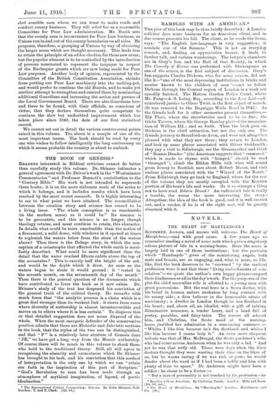RAMBLES WITH AN AMERICAN.•
THE plot of this book may be thus briefly described : A London solicitor does some business for an American client, and in due course presents his bill. The client, as he reads the items, says : " The English law-language is very suggestive ; it reminds one of the Sonnets." This is not an everyday remark, and, finding an appreciative hearer, it leads to further talk, and various wanderings. The lawyer's chambers are in Gray's Inn, and the Hall of. that Society, in which The Comedy of Errors was performed with Shakespeare as one of the actors, is the first subject of discussion. Gray's Inn suggests Charles Dickens, who, for some reason, did not like it—" one of the most depressing institutions in bricks and mortar known to the children of men "—and to follow Dickens through the Central region of London is a work not speedily finished. The Hatton Garden Police Court, where Mr. Fang—A. S. Laing, Esq., according to the Law List—ad- ministered justice to Oliver Twist, is the first object of search. (It was removed to the Bagnigge Wells Road in 1842.) As. the friends lodk for it other memories present themselves,— Ely Place, where the strawberries used to be so fine ; the Globe Tavern, where Sir George Barclay plotted the assassina- tion of William III.; and so forth. Thus the book goes on. Dickens is the chief attraction, but not the only one. The friends journey to Stratford-on-Avon, and were not altogether pleased with what they saw there ; they return to London, and look up some places associated with Oliver Goldsmith ; they pay a visit to Edinburgh, see the Grassmarket and think of "Bonnie Dundee " (the American suggests that" crammed," which is made to rhyme with " hanged," should be read " thranged "), climb the Eildon Hills, talk what will sound gross heresy to Scottish ears about Robert Burns, and visit various places associated with the " Wizard of the North." From Edinburgh they go back to England, where for the rest of the volume they are mostly occupied with the Kentish portion of Dickens's life and works. (Is it so strange a thing not to have read Edwin Drood? An unfinished tale is really a trouble, the worse the more interesting the story.) Altogether, the idea of the book is good, and it is well carried out, and a reader, if he is of the right sort, will be greatly charmed with it.














































 Previous page
Previous page